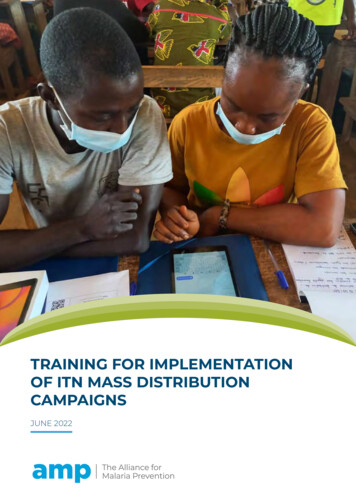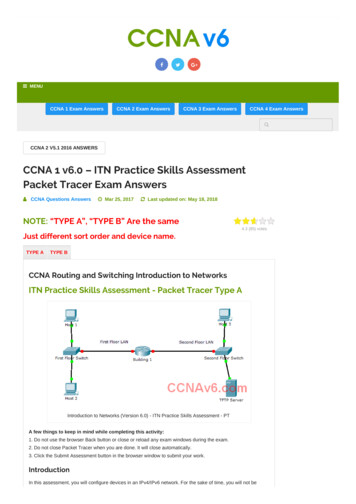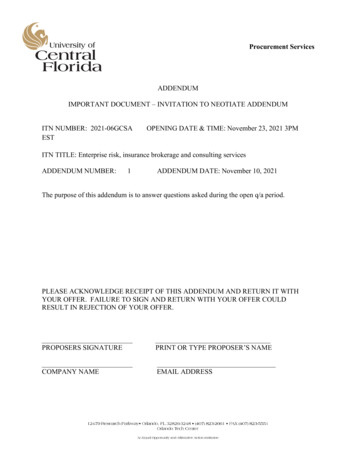
Transcription
TRAINING FOR IMPLEMENTATIONOF ITN MASS DISTRIBUTIONCAMPAIGNSJUNE 2022
CONTENTS1. Introduction 1.1.3Why do training? 31.2. Who needs training? 31.3. What makes a good trainer? 52. Macroplanning and budgeting for training 62.1. Decide on the training sessions required 62.2. The cascade training system 82.3. Decide on number of days of training for implementation 102.4. Decide on the timing for training sessions for different campaign actors 122.5. Budgeting for training 133. Preparation for training 3.1. Prepare all materials based on adult learning principles 3.2. Develop materials 3.2.1. Training agendas 3.2.2. Training manuals 3.2.3. Additional training materials 1414151621223.3. Procure printing and production services and transport 234. Considerations for successful implementation of training 244.1. Select personnel 244.1.1. Central, regional and district personnel 254.1.2. Sub-district (health facility and community) personnel – Household registration andITN distribution teams 254.1.3. Community supervisors of household registration and ITN distribution teams 264.2. Verify on-site preparations 274.3. Planning and preparation by facilitators 284.4. Listen to participant feedback and evaluate the training 28Specialized training All photographs ( ) Programme National delutte contre le Paludisme, GuineaCover photograph: Training of a householdregistration teams on digitalization, Koropara230
1. INTRODUCTIONFor ITN mass distribution, training ofcampaign personnel at all levels is a criticalactivity. It is considered a relatively high-riskactivity in terms of the financial investmentmeasured against its effectiveness and mustbe well planned and organized to ensure it isimplemented at the highest quality possible.This in turn will translate into a high-qualityand effective ITN distribution campaign that iswell supervised and monitored and achievesthe objectives of universal access to and use ofITNs distributed. “Training” in this documentincludes all activities designed to build capacity.Training will generally mean imparting morein-depth information and building capacitythrough practice of newly acquired skillsand tools. Training also includes orientation,which introduces people to the objectives andimportance of the campaign without great detailon the actual implementation, and briefing,which implies updating information or givingdetails of specific actions that participants canthen carry out.1.1. Why do training?The objective of training is to improve skills andknowledge related to specific competenciesso as to improve a trainee’s capability, capacityand performance. When trainers do their jobwell, training allows everyone participating inan activity to be brought to a similar level ofskills and knowledge, which in the case of theITN mass distribution will ensure consistencyduring implementation.Training must be justified, well planned for,implemented at high quality and supervised toensure that information is being communicatedcorrectly and consistently by trainers.Training strategies and methods must ensurethat the investment in training leads to thedesired outcomes, which means sessions andapproaches must be adapted to the level andcapacity of the people being trained1.1.2. Who needs training?All personnel involved in any aspect of the masscampaign – whether operations, social andbehaviour change (SBC), logistics, monitoringand evaluation (M&E), supervision, finance, etc.– require training at all levels of the campaignstructure (e.g. central, regional, district, healthfacility and community2).The people to be trained will depend on thecampaign strategy, as well as the strategy forlogistics, SBC, M&E, etc. As the strategy for eachtechnical area is developed, the levels at whichcampaign activities will be implemented andthe people who will implement the activitieswill be defined and these decisions will alsodetermine who will need training.As a general rule, training takes place from thecentral level, equipping the national malariaprogramme and implementing partnerstaff with the required skills to both train thecampaign personnel at the regional and/or district levels and equip them with thenecessary information, tools and skills for thesub-district trainings and to subsequentlysupervise and/or monitor the campaignimplementation and outcomes.The people to be trained should be identifiedat the macroplanning stage and their roles andresponsibilities in the campaign clearly defined.Trainees at the regional, district, health facilityand community level may include:1. See also Section 3.1 for principles of adult learning.2. Some countries may use different administrative and hierarchical divisions, such as State, Local government authority, etc. The functionis, however, similar.3
zMinistry of Health staff at each level,including malaria focal persons at regionalor district level, the health facility officerin-charge, the district logistics focalperson, SBC focal point, and otherszImplementing partner staff at subnational levels based on roles andresponsibilities in the campaign structurezLocal level (regional, district, community)leaders and influencers who will have a rolein the campaign for mobilizing households,responding to bottlenecks and challengesand managing any mis- or disinformationabout the campaign or ITNszCommunity health workers or othercommunity actors who will interactwith household members duringthe household registration and ITNdistributionTraining, orientation or briefing is implementedfor different cadres of campaign stakeholdersand personnel for each technical area (seeTable 1 for some examples).Table 1: Examples of personnel to be targeted for capacity-building across technical areasLogisticsCentral, regional, district logisticiansWarehouse managers and assistant warehouse managers Security personnel Conveyors Distribution point supervisors Contracted or third-party transport companies Central, regional, district SBC focal pointsPolitical, religious, traditional leaders at all levels from central to community Media representatives at levels where they are present Town announcers, motorized street announcers and drama troupesat community level and their supervisors Door-to-door social mobilization teams at community leveland their supervisors Civil society organizations, schoolteachers and other targeted communitylevel SBC actorsSBC M&E Central, regional, district data managers, as well as regional and districtmalaria programme staff involved in data management and feedback Supervisors of household registration and ITN distribution personnel atcommunity level Supervisors at district, regional and central level Internal monitors Independent monitorsOperations Finance 4Household registration personnelITN distribution personnelCentral, regional, district finance focal pointsAny other personnel at central, regional, district or sub-district levels that haveresponsibilities related to finance and payments (e.g. supervisors that may beresponsible for ensuring justifications for work are submitted on time)
1.3. What makes a good trainer?Training is a form of capacity-buildingor sharing knowledge to reinforce thequality and consistency of activities duringcampaign implementation. It requires specificcharacteristics among trainers to ensure thatinformation can be passed to trainees in a waythat ensures understanding and retention.Some of the characteristics that make trainerseffective include:zzzzzDeep knowledge of the subject –trainers should be experts in the subjectarea, able to respond to any questionsarising from trainees. It is even better ifthey are knowledgeable and passionateabout the subject.Strong communication andinterpersonal skills – trainers must beable to articulate their ideas clearly andconcisely and must be able to developrapport with the trainees to ensure a safeand comfortable learning environment.Being a good listener is part of being astrong communicator.Passion for continuous learning – thebest trainers enjoy learning, which ensuresa training environment that supportsexchange of experience and learning fromone another.zzOrganization – trainers that plan early,ensure that materials are available,prepare specific timed facilitation plans,and organize their training sessions tobe interactive and run on time are moreeffective and better able to keep traineesengaged.Strategic thinking and innovativeapproaches – trainers that assessthe needs of the trainees and theirbackgrounds to find ways to best engagethem in the training process will bemost effective. Innovative and flexibleapproaches to keep trainees active,thinking, contributing and learning fromone another will result in better trainingoutcomes.Self-reflection – trainers that review thetraining experience and identify positiveelements and areas for improvementare trainers that will continue to improveon the training experience and achievedesired training outcomes.Commitment to “sticky learning” –trainers should aim for participants toretain information learned during thetraining so that they are able to applythe learning during the campaignimplementation that follows, and for yearsto come. To achieve this, trainers presentcontent in memorable ways and organizetraining activities to continually build on,practise and test information learned.A trainer of householdregistration teams atwork, Koropara5
2. M ACROPLANNING AND BUDGETINGFOR TRAININGAt the macroplanning stage, a number ofdecisions concerning training are requiredin order to finalize the timeline and budget,as well as the campaign plan of action, thelogistics plan of action and the SBC plan ofaction (and any other plans, such as M&E,finance or risk mitigation. National malariaprogrammes should take into accountthe strengths and weaknesses of previouscampaign training and ensure that theseare addressed as they plan for their currentcampaign.2.1. Decide on the training sessions requiredPlanning for training takes place early, duringthe macroplanning for the campaign. Thetraining sessions required, the number of levelsof the training cascade (if applicable) and thetraining participants and facilitators mustbe decided at this stage to ensure that thebudget reflects the plans for capacity-buildingat each level and for each activity.Training sessions required should be based onthe global objectives of what training is tryingto achieve in the context of an ITN campaign,including:zEnsuring that all households are reachedduring registration, registered correctly,provided with a voucher for the correctnumber of nets (where this is the strategy)and are aware of when, where and howto retrieve their ITN(s) during the ITNcampaign distribution activitieszEnsuring that households receive thecorrect number of ITNs during thedistribution and that nets are correctlyaccounted for during and at the end ofthe distributionzEnsuring that the targeted population ismobilized to participate in the campaignand that the correct SBC messages arepassed consistently during each phase ofactivitieszEnsuring that the ITNs can be accountedfor from the point of arrival through thesupply chain to the households, as well asduring reverse logistics at the end of thedistribution (see AMP Toolkit, Chapter 5,Brief 7, Logistics training)3zEnsuring that waste management isimplemented according to the plansand that the campaign does not have anegative environmental effectNational malaria programmes may have otherobjectives, but globally, the training sessionsplanned and budgeted at a minimum shouldlead to these programmatic and accountabilityoutcomes.Training sessions may cover all the campaigntechnical areas or they may be focused onlyon a specific technical area. At the centrallevel, there may be both kinds of training.Covering all the campaign technical areas willensure that the individuals that will be trainingothers or supervising or monitoring campaignimplementation have sufficient skills andknowledge to address problems in any area(such as data collection or poor communityparticipation). In addition, central staff willneed focused training to ensure, for example,that there is high accountability for ITNs in thesupply chain through oversight of logisticspersonnel at all levels. A similar approach maybe applied at the regional and district levels.3. t/uploads/2021/03/AMP-Toolkit-report-2015 Chapter5 EN LR-1.pdf6
7
At the community level, campaign workerswill be recruited from the areas where theylive, and they may have less experience withthe different campaign activities. At this level,it is important that the training sessionsare tailored to the specific audiences toensure maximum understanding and highquality campaign outcomes. It is importantnot to overload campaign workers withinformation that they do not need to know.For example, household registration teamsshould be trained on how to accomplishtheir tasks for household registration andSBC. ITN distribution personnel should betrained on activities to distribute and ensureaccountability for ITNs. Similarly, communityleaders should only be trained on their specificroles and responsibilities, which may includemobilizing their community and managingproblems that arise at the community level,rather than being trained about the roles of allcampaign personnel4.2.2. The cascade training systemIn most countries a cascade system (wheretraining is provided to individuals who in turnprovide the same or similar training to others)is used. Generally, a group of trainers from thecentral level train those at regional or districtlevel, who in their turn train staff at the levelof local health facilities. Health facility levelpersonnel are then responsible for trainingthe people who have been recruited forimplementation of household registration andITN distribution activities. Similarly, cascadetraining will take place for logistics, SBC, M&Eand other campaign actors and activities(e.g. training of town announcers /motorizedstreet announcers with specific SBC messagesor training of distribution supervisors specificto their logistics and data management tasks).When implementing cascade training, it isimportant that participants at the centrallevel acquire the skills needed to facilitatetraining and information transfer to theother levels. Care must be taken at eachlevel of the cascade that no information islost or misrepresented. Trainers at all levelsmust have clear knowledge of the content ofthe training and must be able to clarify anymisunderstandings. Weaknesses at the upperlevels are carried over to the next level, witha corresponding effect on quality during theimplementation of activities.Cascade training is helpful and saves time, but care must be taken to maintain highquality training throughout the levels. Wherever possible, national malaria programmesshould try to limit the number of levels in the training cascades to ensure standardcontent is passed down the chain to guarantee the quality of the training.It is possible to minimize the potential lossin training quality by limiting the numberof cascades. For example, countries whichhave a four-tier system of health delivery maycombine the central and regional level intoone group of master trainers who then trainthe trainers from district level. District levelfacilitators then train the health facility staffwho in their turn facilitate the training ofthe recruited campaign personnel who willundertake the household registration, ITNdistribution and supervision of these activities.National malaria programmes should assessthe number of cascades required based ontheir health system and campaign strategy(see Figure 1).4. See: Engagement of community leaders in ITN distribution in the context of COVID-19 transmission. EN.pdf. Note that the engagement principles apply even whenCOVID-9 is no longer a consideration.8
Figure 1: Steps in the training cascade (example)4 step training cascade3step training cascadeSTEP01Central level training oftrainers (ToT) for only centrallevel personnelSTEP01Central level trainingof trainers (ToT)central and regional personnelSTEP02Regional (ToT) for regionallevel campaign personnelfacilitated by central trainersSTEP0303Regional (ToT)for regional levelcampaign personnelfacilitated by centraltrainersDistrict level (ToT) for district andhealth facility level personnelfacilitated by regional trainersSTEP04STEP02District level ToTfor district and health facilitylevel personnel facilitated bycentral and regional trainersHealth facility/community leveltraining for household registrationteam members and communitysupervisors, and for ITN distributionteams and supervisors for fixed pointor door-to-door distributionSTEP039
In Figure 1, the right side of the figure illustrateshow the number of levels in the cascadetraining is reduced by grouping the regionalcampaign personnel with the central levelpersonnel. Other alternatives are possible forreducing the number of levels for training, suchas training district personnel at the regionallevel or health facility personnel at the districtlevel. Options should be determined based oncountry context with an overall effort to limit thenumber of step-down trainings and potentialloss of content from one level to the next.2.3. D ecide on number of days of trainingfor implementationOnce the training sessions required have beendetermined, the number of days required foreach session should be agreed. For all trainingsessions, whether for SBC, logistics, M&E, datamanagement, etc., the number of days requiredshould be based on the content that needs tobe covered, the existing capacity of the traineesthat will be participating in the session andspecial conditions that may require less trainingtime per day (e.g. limited training hours incomplex operating environments to ensure thatpeople arrive home before sundown). Increasingthe training duration by one additional daywhere central, regional or district personnelhave significant tasks related to finance andpayments or by one additional day in insecureareas to allow the content to be covered inthree days of five hours rather than two daysof eight hours are examples to consider whendetermining the number of training days.In general, the following is recommended interms of training for implementation:zCentral level training5 of trainers (ToT):The central level ToT can either be doneonce, covering all phases of activity (pre/during/post), or can be split into separatetrainings for the household registrationand ITN distribution phases. The centrallevel ToT may be four or five days total(whether in one or two training phases)and the days may be split into integratedsessions, where all participants receiveinformation about all technical areas, andthen standalone sessions, where SBC,logistics and M&E personnel receive amore in-depth training related to theirspecific roles and responsibilities in termsof training, supervision and/or monitoringfor their technical area.zRegional training of trainers: In somecountries, it is possible to bring theregional campaign personnel to thecentral level ToT since the content ofthe training, as well as the roles andresponsibilities of participants duringimplementation, is similar if not identicalfor the two levels. Where this is notpossible due to distance or number ofparticipants being too high for a singletraining session at the central level,regional level training should normallybe planned for the same number of daysas the central ToT. If, however, there aresignificant differences in the tasks thatpersonnel at this level are responsible forvis-à-vis those of the central personnel,then the number of days may beincreased or decreased accordingly basedon the agenda developed and trainingmodules added or removed.zDistrict training: The training of districtlevel campaign personnel should bethree to five days depending on the rolesand responsibilities of the campaignworkers at the district level and whetherthey will be trained for both householdregistration and ITN distribution at thesame time. Where separate trainings willbe organized for the two phases of activity,each should be two to three days to allowfor sufficient focus on all implementationlevel activities for household registrationand ITN distribution, from planning forteam deployment to SBC, logistics andITN reconciliation, data management andreporting on the activities achieved.5. Note that this training brief does not include training for microplanning, which requires a separate activity and training days.See Microplanning guidelines: /tools-resources/10
zHealth facility and community leveltraining: There are a number of trainingsessions that take place at this leveldepending on the campaign strategy, aswell as the SBC and logistics strategies.Trainings at this level may include:¾ Training of household registration teammembers and community supervisors,with a focus on data collection and SBC,should take place over a minimum oftwo days. It is not recommended toshorten this training to one day as thequality of the household registrationphase determines the quality of theoverall campaign, since an unregisteredhousehold is not eligible to receive anITN in most countries.¾ Training of community supervisors forhousehold registration, with a focus onthe development of team route maps,synthesizing of daily data and reportingon any incidents arising, should beorganized for a minimum of one dayafter the training of the householdregistration team members. In somesituations, where community supervisorsare clearly identified within thecommunity health structure or for otherreasons, the national malaria programmemay opt to train the communitysupervisors prior to training thehousehold registration team members,particularly if these supervisors aretasked with training the people they areresponsible for during implementation inthe cascade structure.¾ Training of distribution teammembers, with a focus on managingthe distribution point or the doorto-door distribution, and on clearcommunication with householdrepresentatives, collection and collationof daily distribution data and SBCC6activities, should take place for aminimum of one day, ensuring that allteam members understand their rolesand responsibilities.¾ Training of pre-positioning site ordistribution point supervisors, witha focus on the organization of thedistribution point and roles andresponsibilities of distribution teammembers, the collection of daily dataand the management of the ITN stocks,should be organized for a minimum ofone day prior to or after the training ofthe distribution point team members.The timing for the training of the prepositioning site or distribution pointsupervisors will depend on whether theyare responsible for the training of thedistribution team members or whetherthe training of the distribution teammembers will take place at a higher levelwith multiple teams grouped togetherin one session.It is not recommended to combine the training of personnel for household registrationand ITN distribution at the community or health facility level. Combining the two maylead to low-quality implementation of both activities and poor ITN accountability givenlimited ability to retain all the data collection aspects, as well as SBC messaging. At theimplementation level, separate trainings must be organized for each phase of activities,and it is recommended that community (team) or distribution point supervisors aretrained both together with and separately from team members for each phase ofactivities to ensure that they understand all the tasks of the team members, as wellas their specific tasks related to high quality data and management of the campaign.6. Communication specifically to change behaviours, including service utilization, and promote social change by positively influencingknowledge, attitude and social norms.11
¾ Training or orientation of townannouncers and motorized streetannouncers, with a focus on ensuringthat the messages communicatedfor household registration and ITNdistribution are clear and consistent,should be organized for a minimumof a half-day in advance of each phaseof activity.¾ Training or orientation of communityleaders, with a focus on mobilizationof households in their communities,identification and resolution ofproblems, responding to questions fromcommunity members and supportingthe successful implementation of thecampaign should be organized for aminimum of one day in advance ofcampaign activities being implemented.¾ Training or orientation of teachers (if partof the strategy selected) so that they cancreate awareness among schoolchildrenabout malaria, the use of ITNs and theimportance of sleeping under an ITNevery night of the year. Children act asagents of change within their familiesand communities.2.4. Decide on the timing for training sessionsfor different campaign actorsAs described above, decisions will need to betaken during macroplanning as to whetherthe training of trainers (who will then becomefacilitators, supervisors and/or monitors) willbe done in one session covering all activitiesor in two sessions aligned to the householdregistration and ITN distribution phases.district level where campaign personnel maybe implementing activities with no previousexperience base. In this case, the trainingneeds to be both practical and interactive andorganized no more than two to three daysbefore starting the activity (e.g. householdregistration or ITN distribution).Timing for additional training sessions for SBC,logistics and M&E also needs to be determined.The timing for the training sessions should bearrived at by working backwards from the datethat implementation of the specific activity(e.g. household registration or ITN distribution)will start.In some cases, household registration andITN distribution training sessions have beenconducted together based on the anticipatedshort delay between the two activities. Thisscenario presents risks in terms of retentionof information for the ITN distribution phasewhen it is received in advance of the householdregistration and for information to be completelyforgotten if there is a longer than expected delaybetween the two activity phases. Where thisoccurs, it will be necessary to organize refreshertraining for campaign personnel, which createsadditional, unplanned expenses.Appropriate timing of training sessions willhelp ensure that the trainees retain theknowledge that they have acquired sincethey are immediately putting it into effect.This is particularly important at the sub-The head of the healthcentre in Koropara giveshis support to trainees12
2.5. Budgeting for trainingTraining is an expensive activity and is oftenhighly scrutinized during the external review ofmacroplanning documents and the campaignbudget. The budget for training must be clearlylaid out, including:zVenue rental (as well as generator, soundsystem or projector rental where required)zFacilitation fees, as well as facilitator transportand per diem (based on finance policies)zParticipant transport and per diem (basedon finance policies)zRefreshment breaks and lunches (basedon finance policies)zTraining materials (photocopies and printing)zTraining packages (folders, notebooksand pens)zTraining supports (such as flipcharts,flipchart paper, markers, post-it notes, etc.)It is critical to budget for the photocopies andprinting required for the training separatelyfrom those required for implementation. Thecontingency stock added to the implementationmaterials (e.g. number of household registrationforms 15 per cent) is insufficient to cover thetraining needs for materials for practical exercises.The draft list of materials for each training, basedon those to be used during implementation,should be developed at the macroplanning stageand quantified and budgeted appropriatelyto avoid anything being forgotten during theimplementation. See section 3.2 for guidanceon development of materials.Failure to quantify and budget separately for all tools required for practical exercisesduring training will compromise the quality of the training by limiting practice withthe key tools required for data collection and accountability.It is recommended that the number ofparticipants in each training session is criticallyreviewed during planning and budgetingto ensure that the training environment issuitable for question and answer, plenarydiscussion and practical exercises. Wherethere are too many people in a trainingsession, it is difficult for the facilitators to ensurefull participation in an interactive manner byall trainees. As a general guideline, the numberof participants in a training session should notexceed 25—35 people. When larger trainingsessions are planned because of budgetconstraints they tend to be less effective.Cost-savings in budgets should ideally beidentified elsewhere.At all levels of training, sessions should besupervised, using standardized tools, to ensuretheir quality and to check that information isbeing correctly communicated by facilitatorsand retained by participants. Additionally,training evaluations should be done at eachlevel to ensure that any identified weaknessescan be addressed either before the nextlevel of training or, as needed, during theimplementation of activities. Supervision oftraining should allow for immediate remedialaction if it is found that incorrect or incompleteinformation is being passed on. Supervisionof training must, therefore, be included inthe budget.13
3. PREPARATION FOR TRAININGBased on the decisions taken duringmacroplanning concerning trainingsessions required, training preparationshould begin as early as possible. Thisincludes development of agendas,training manuals, handouts, role-playscenarios, practical exercise
daily data collection, summary and transmission of data, the importance of the SBC messages to be passed and the critical need for highly effective supervision. Definition of a household and ITN allocation should be a major focus of the module as non-adherence to the definitions during implementation will, at times, be a reflection of










